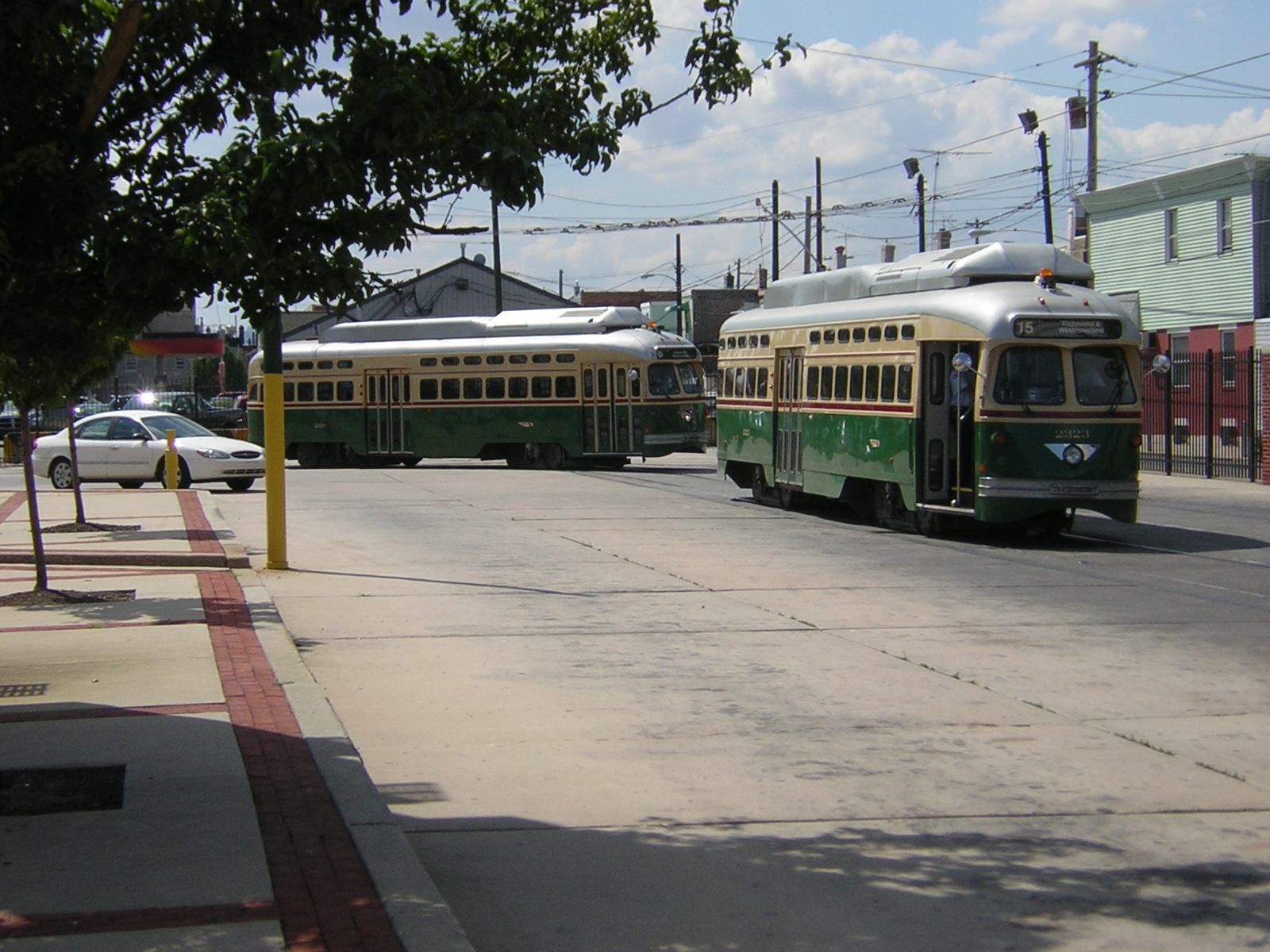- SEPTA Route 15
Infobox rail line
name = color box|#SEPTA color|Route 15 Route 15
Girard Avenue Trolley
imagesize = 150px
locale =Philadelphia, PA
type =Streetcar line
start = 63rd Street and Girard Avenue
end = Richmond and Westmoreland Streets
open = 1859; 2005 (resumed)
linelength = 8.5 mi [Railway Age , Cash-short SEPTA presses on with capital program,October 1 ,2004 ] (13.7 km)
el =Overhead lines
gauge =Pennsylvania Trolley Gauge : RailGauge|62.5
operator = SEPTARoute 15 is a
heritage streetcar line, operated by theSoutheastern Pennsylvania Transportation Authority (SEPTA), alongGirard Avenue through North andWest Philadelphia ,Pennsylvania ,United States .As of 2007 , it is the only surface trolley line in the City Transit Division that is not part of the Subway–Surface Trolley Lines.PCC streetcars are used on the line.The line was first opened in 1859 as a
horse car line operated by the Richmond and Schuylkill River Passenger Railway, and electrified in the 1890s.Fact|date=May 2007 Service was suspended (replaced withbus es) in 1992, along with Route 23 (Germantown Avenue-11th and 12th Streets) and Route 56 (Wayne-Erie Avenues). OnSeptember 4 ,2005 , trolley service was restored.Route
The tracks for 8.5
mile (13.7 km) Route 15 run alongGirard Avenue and Richmond Street. The Western terminus is at the intersection of Girard Avenue and 63rd Street, and the Eastern terminus is at the intersection of Richmond Street and Westmoreland Street. The line provides access to theMarket-Frankford Line 's Girard Station and to theBroad Street Line 's Girard Station.History
The Richmond and Schuylkill River Passenger Railway was chartered by the
Pennsylvania General Assembly onMarch 26 ,1859 to operate along Girard Avenue between theGirard Avenue Bridge over theSchuylkill River in Fairmount Park and Norris Street in Richmond, with an extension authorized west over the bridge toLancaster Avenue .Public Laws 241 and 242 of 1859 and 1862 of 1861, reprinted in Law Department of the City of Philadelphia, [http://books.google.com/books?id=pFM9IQEaeNQC A Digest of Laws Relating to the City of Pennsylvania] , 1865, pp. 111-113 (appendix)] The line opened from Second Street to 31st StreetHarold E. Cox, Philadelphia Car Routes, 1982, cited in PDFlink| [http://web.archive.org/web/20060112215152/http://www.publictransit.us/ptlibrary/specialreports/Railopenings.pdf U.S. Urban Rail Transit Lines Opened From 1980] |1.47 MB, 2005] in July 1859.Fact|date=May 2007 The company was sold atforeclosure and reorganized as the Fairmount Park and Delaware River Passenger Railway onJune 14 ,1864 ,Fact|date=May 2007 and was merged into theGermantown Passenger Railway (Route 23 Germantown Avenue) onFebruary 15 ,1866 . [http://books.google.com/books?id=Yn-jZRn57YUC American Street Railway Investments] , a Supplement to theStreet Railway Journal , 1897, p. 198, 200, 204]Extensions were opened east to Palmer Street in 1866 (looping via Palmer, Beach, and Shackamaxon StreetsWilliam B. Atkinson, [http://books.google.com/books?id=mk22oTvu_F4C The Philadelphia Medical Register and Directory] , 1875] ) and to Norris Street in 1875. The
People's Passenger Railway leased the line onOctober 1 ,1881 , and leased the Girard Avenue Railway (charteredMay 17 ,1894 ) onJune 22 ,1896 , extending the line west to 60th Street in 1900. TheUnion Traction Company leased the People's Passenger Railway onJuly 1 ,1896 , giving it control over almost all the street railways in Philadelphia. Girard Avenue cars were extended west to 63rd Street and east to Allegheny Avenue - the latter extension along the ex-Electric Traction Company Bridesburg Line on Richmond Street - in 1903, and eventually replaced the Bridesburg Line entirely to Bridesburg.Fact|date=May 2007In
1992 , SEPTA replaced trolley service along Routes 15, 23, and 56 with buses. The 15 line has been reopened as a trolley service in September 2005 after having been served by buses for thirteen years. To prepare for the resumption of trolley service, SEPTA spent a total of $88 million, including rehabilitating the tracks and repairs to the overhead wires. The rolling stock for Route 15 consists of PCC II cars, which are1947 PCC streetcar s that had been completely rebuilt by the Brookville Equipment Company as a cost of $1.3 million per trolley. The rebuilt trolley includes the addition of air conditioning and regenerative braking. ["Philadelphia's PCCs Return to Service." "Railway Age." Vol. 205, No. 10, p. 30. October 1, 2005.] The restoration of trolley service was delayed because of a long fight with local residents on 59th Street, which the trolleys needed travel down in order to access the Callowhill Depot, over parking on the street. [ [http://citypaper.net/articles/2004-09-30/cb5.shtml] Amy L. Webb (2004). "Communication Breakdown." "Philadelphia City Paper." September 30, 2004.]References
External links
*PDFlink| [http://www.septa.org/service/sched/pdfs/015.pdf Route 15 schedule] |84.7 KB
Wikimedia Foundation. 2010.
